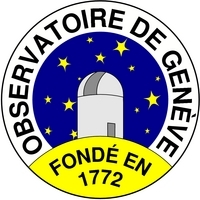
| INTEGRALPlanckGaiaPOLARCHEOPSEuclidATHENA |
| HEAVENSFACTCTALOFTSPICAJEM-EUSOXIPEeXTPTheseus |
| XRISMMAGBOUNDSMARTNet |
| ISDCCDCI |
| Data Centre for Astrophysics Astronomy Department of the University of Geneva |
Seyfert 2 galaxies in the GeV band: jets and starburst
| We present Fermi/LAT data analysis of two unusual suspects in the GeV band, NGC 1068 and NGC 4945, which are both composite starburst/active galactic nuclei objects. We show that the GeV emission of NGC 4945 could be interpreted in terms of starburst activity, while the one of NGC 1068 should account for a dominant contribution from the central AGN. |
|---|
ABSTRACT
The Fermi/LAT collaboration recently reported the detection of starburt galaxies in the high energy γ-ray domain, as well as radio-loud narrow-line Seyfert 1 objects. Motivated by the presence of sources close to the location of composite starburst/Seyfert 2 galaxies in the first year Fermi/LAT catalogue, we aim at studying high energy γ-ray emission from such objects, and at disentangling the emission of starburst and Seyfert activity. We analysed 1.6 years of Fermi/LAT data from NGC 1068 and NGC 4945, which count among the brightest Seyfert 2 galaxies. We search for potential variability of the high energy signal, and derive a spectrum of these sources. We also analyse public INTEGRAL IBIS/ISGRI data over the last seven years to derive their hard X-ray spectrum. We find an excess of high energy γ-rays of 8.3 σ and 9.2 σ for 1FGL J0242.7+0007 and 1FGL J1305.4-4928, which are found to be consistent with the position of the Seyfert 2 galaxies NGC 1068 and NGC 4945, respectively. The energy spectrum of the sources can be described by a power law with a photon index of Γ = 2.31 ± 0.13 and a flux of F100 MeV-100 GeV =(8.60 ± 2.27) × 10-12 erg cm-2 s-1 for NGC 1068, while for NGC 4945, we obtain a photon index of Γ = 2.31 ± 0.10 and a flux of F100 MeV-100 GeV =(1.58 ± 0.32) × 10-11 erg cm-2 s-1 . For both sources, we detect no significant variability nor any indication of a curvature of the spectrum. While the high energy emission of NGC 4945 is consistent with starburst activity, that of NGC 1068 is an order of magnitude above expectations, suggesting dominant emission from the active nucleus. We show that a leptonic scenario can account for the multi-wavelength spectral energy distribution of NGC 1068. High energy γ-ray emission is revealed for the first time in a Seyfert 2 galaxy. If this result is confirmed in other objects, new perspectives would be opened up into the GeV band, with the discovery of a new class of high energy γ-ray emitters.
| by Jean-Philippe Lenain on 2010-10-18 | >> Fermi science results | >> All science results |







